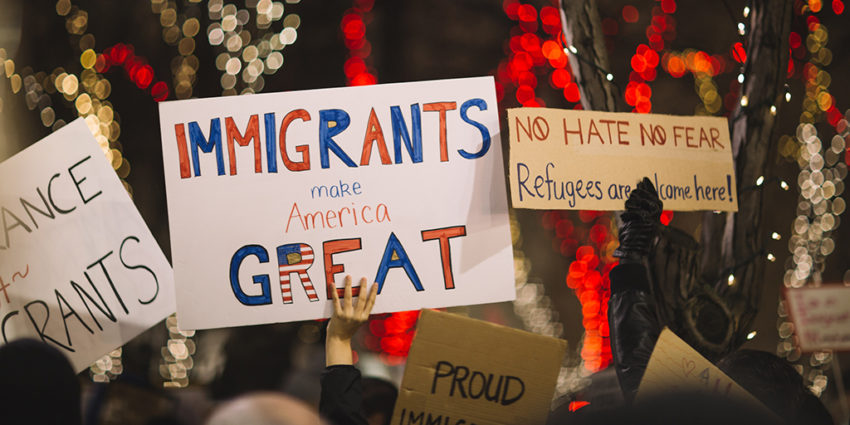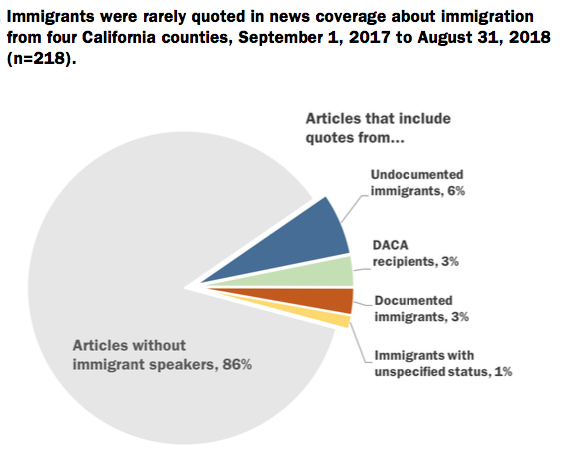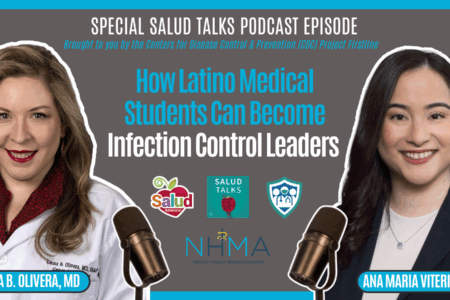
Share On Social!
California media portray immigrants with derogatory descriptions with regularity, while immigrant voices and healthcare are rarely covered, according to a new report by Berkeley Media Studies Group (BMSG).
The BMSG report examined over 2,500 immigration articles in 2017-2018 in California: Monterey (58.8% Latino), Sacramento (23.3% Latino), Kern (53.4% Latino), and San Diego (39.1% Latino).
Researchers found neutral descriptors of immigrants—“undocumented” or “unauthorized”—in most media coverage.
But they also found potentially dehumanizing terms—“illegal immigrants,” “illegal aliens,” or “illegals”—in nearly every news outlet, and 13% of all articles examined.
No coverage focused on the health and well-being of immigrants, either.
“The hostile political climate facing immigrants in many parts of California means that communicating strategically and centering equity in those narratives is both challenging and urgent,” according to BMSG.
The News Media Analysis
BMSG’s analysis delivers a summary of how immigration is portrayed by California local media.

The four counties represent a diverse set of conditions and areas that include border communities, the Central Valley, and the state capitol.
San Diego County having the most news coverage at 1,347 articles.
Sacramento County followed with 580 articles, then Monterey County with 499 articles. Kern County had the least with only 93 articles.
In these counties:
- Federal immigration issues dominated coverage. Overall, coverage of state and local sanctuary policies accounted for 17% of news articles across the four counties.
- State and local sanctuary policies garnered substantial coverage. For example, stories covered Border Patrol arrests in the area.
- Stigmatizing language about immigrants sometimes appeared. These include terms like “illegal” and “aliens.”
BSMG found the actions of the Trump Administration drove the news about immigration in the four counties.
Local issues and initiatives got little attention.
“Understanding the current narrative around immigration as it is reflected in news coverage can reveal gaps in the story about immigration and provide direction for strategic communication,” according to BMSG.
Public Health NOT Part of News Narrative
Public health got left out in media coverage of immigration.
The term “public health” never appeared, according to the BMSG report.
For example, the Trump administration’s proposed Public Charge rule, which would penalize legal immigrants applying for green cards if they use public benefits, such as food assistance, received less than 1% of coverage in articles.
Similarly, California legislative efforts to expand Medi-Cal to cover undocumented immigrants received less than 1% news coverage.
This report is bad news for Latinos and their health.
The current political climate of inflammatory rhetoric, parental separation, and tear-gassing of migrants along the border, have made many Latinos feel the burden of an anti-immigrant climate.
Immigrants Inequitably Represented in News Media
BMSG findings showed government officials dominated immigration coverage. 65% of articles had government representation, including federal, state, and local officials.
Immigrants were seldom represented, with only 14% quoted in the coverage.
Documented immigrants were rarely quoted on immigration issues. When they did appear in the news, they discussed the immigrant experience.
Undocumented immigrants were only represented in 6% of articles. Although 20% of all articles mentioned DACA, only 3% quoted DACA recipients.
These groups often were quoted on their emotionally charge experiences. Deportation was another fear.
“Being separated from my daughter and my wife was the most painful thing of my life. I felt powerless. … They treated us like criminals.”
Solutions to Improve the Narrative
 BMSG wanted to see if this was just a California issue.
BMSG wanted to see if this was just a California issue.
So they expanded their analysis to top national newspapers over the same time span.
They found that on average, about 15% of articles about immigration contained derogatory, misleading, or racist terms in reference to immigrants.
“The New York Post, Washington Post blogs, The Washington Post, and The New York Times had the most articles with stigmatizing language about immigrants,” according to a BMSG blog post.
BMSG suggests building a stronger narrative about immigration that supports health and race equity:
Strategically responding to news about federal actions, like public comments!
- More than 200,000 people spoke up against public charge!
- Comment NOW to save SNAP!
Generating news coverage that combats false narratives about immigrants.
Debunk stereotypes that immigrants take more from the government than they contribute. In fact, immigrants boost the U.S. economy.
Bringing health into the narrative.
For example, Minerva Perez is stepping up to help Latinos with her three-hour workshops—called Círculos de Fuerza, or Circles of Strength—to enable Latino families to express their stress and fears in English or Spanish, and lean on each other for support, all with guidance from licensed mental health professionals.
Check out a Doctor’s Mental Health & Resiliency Training for Immigrant Kids in Schools.
By The Numbers
3
Big Excuses
people use to justify discriminatory behavior



